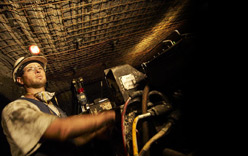GAS UTILISATION
Overview
The excavation of coal as part of the mining process
causes gas to be released which passes into the mine ventilation air and is
exhausted through the main fans on the surface. In some mines however, gas is
captured by a gas drainage system either prior to mining (pre-drainage) or
after mining (post drainage), with captured gas usually being piped to surface.
Note that mines with gas drainage systems do not capture all the gas, and
typically around 50% is still exhausted in the mine ventilation.
The majority of mines vent the captured gas to
atmosphere, in some cases after flaring, although a few mines have, since the
1970's utilized the captured gas to generate power for both mine and community
consumption. There is now a growing move to utilize gas from mines, both
because of a desire to reduce atmospheric pollution and because it is a wasted
resource.
In some cases the captured gas (at least a large
proportion of it) is carbon dioxide and there is no means of utilizing this gas
– it has limited commercial use, such as in soft drinks and fire
extinguishers, which would be only a small fraction of the gas produced by
mines, and it is easier to extract it from normal air.
Many mines however produce methane which can be burnt
to utilise the heat either directly or, more commonly, to generate electricity.
This process actually converts the methane to carbon dioxide and water so
actually increases the carbon dioxide output, but the effect of methane on the
atmosphere is far worse than carbon dioxide, by a factor of around 8.
It would be possible to burn the methane in a boiler
to produce hot water for whatever purpose, but there are no examples of this in
Australia. Two methods are currently used to generate electricity in Australian
mines at present:
-
Burning the methane in a gas turbine which
drives a generator.
-
Burning the methane in a "gas engine", a diesel generator set designed to run on
methane gas as a fuel instead of diesel.
Both methods have proven successful although gas
engines can be designed to run on very lean mixes and so are suited to mines
which produce a mix of gases. Either option is suited to very rich mixes.
Another advantage of gas engines is that they are
typically smaller capacity and are suited to building up capacity of a "power
station" over time by the addition of other units, thereby allowing expenditure
to be spread and for spare capacity to be provided to facilitate maintenance.
In some cases it is beneficial to allow a connection
to an alternative gas supply, if available, to allow generation to continue in
the event the gas supply from the mine becomes too lean. It would not be normal
to continue generating if the gas supply ceases as the main purpose of such a
plant is to utilize mine gas; it would probably be uneconomic to run on
alternative supplies.
In most cases the power produced is utilized in the
mine, feeding in with the external power supply. In the event that the power
produced is greater than the mine usage, the excess if fed into the grid.
Arrangements are made between the mine and the external supplier regarding
payment for power exported. In some cases the gas utilization plant may be
owned and operated by a company other than the mine on a toll basis.
In general, any utilization system should be designed
to operate within the capacity of the gas capture system - any decision to
change mining operations for the benefit of the utilization system would have
to be based on financial or social considerations.
A process which is growing rapidly at present is
referred to as "coal bed methane recovery". This is a process of draining methane from coal
using surface boreholes, usually drilled at an angle other than vertical and
curved to eventually follow a coal seam for some distance. This process is
primarily aimed at recovering methane for commercial use in its own right and
as such is not strictly part of coal mining. It is possible however, and in
some cases is occurring, for a coal mining operation to carry out the same
process primarily to remove the gas to assist later coal mining operations. The
practicality of this process depends on the availability of surface drill sites
and there being sufficiently long lead time available to drill and drain the
gas before the coal is to be mined. Whatever the primary reason for the methane
recovery, it would be utilized either as described above or would be fed into a
gas supply grid. Gas mixtures with a high carbon dioxide content would not be
suitable for the latter.
ACARP reports
– various reports on research work related to use & collection of
gases, in "Mine Site Greenhouse Gas section"
COAL SEAM
METHANE - Sigra – a commercial site for work carried out by Sigra,
but briefly describes equipment and contacts.

